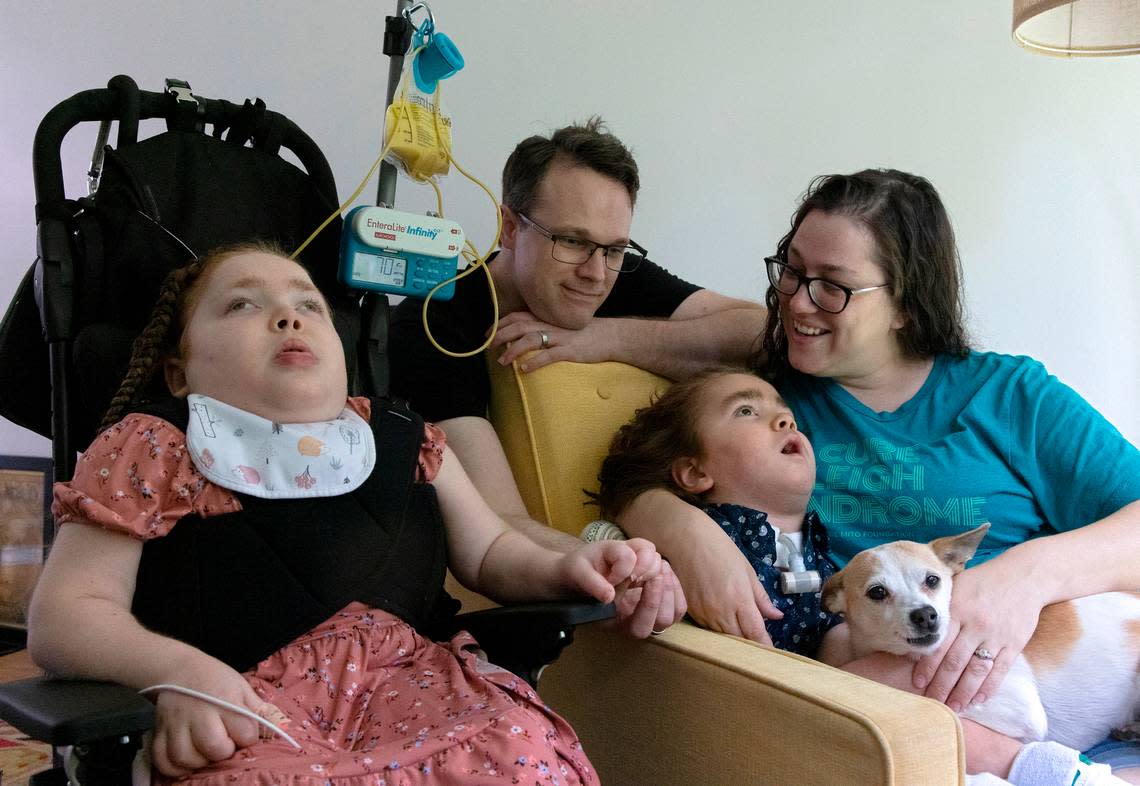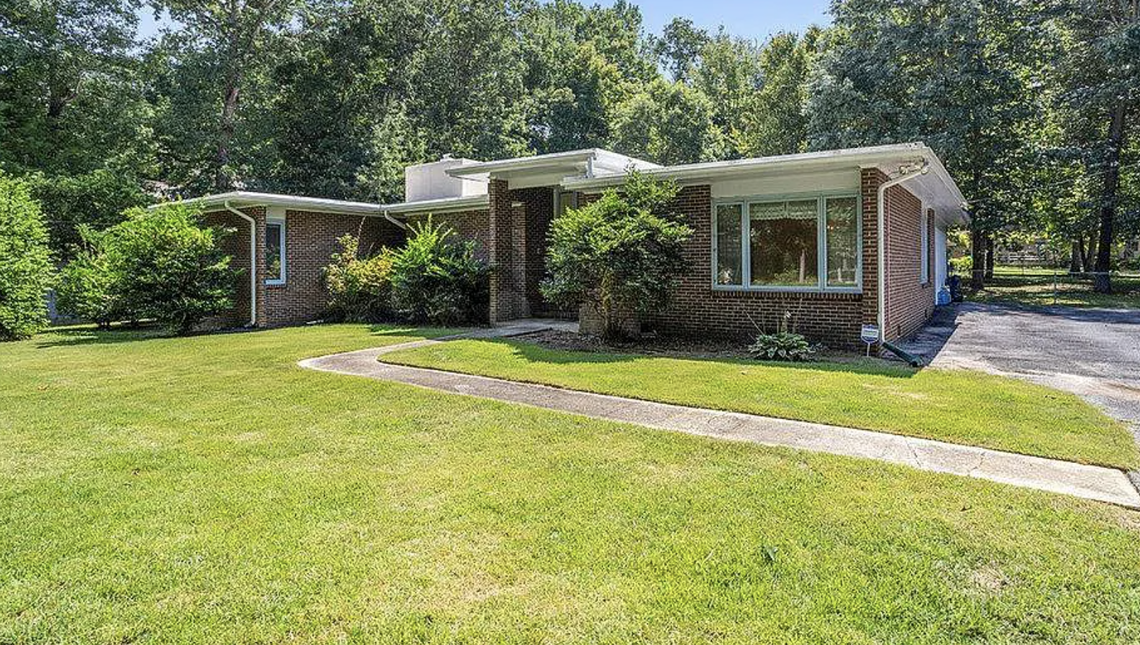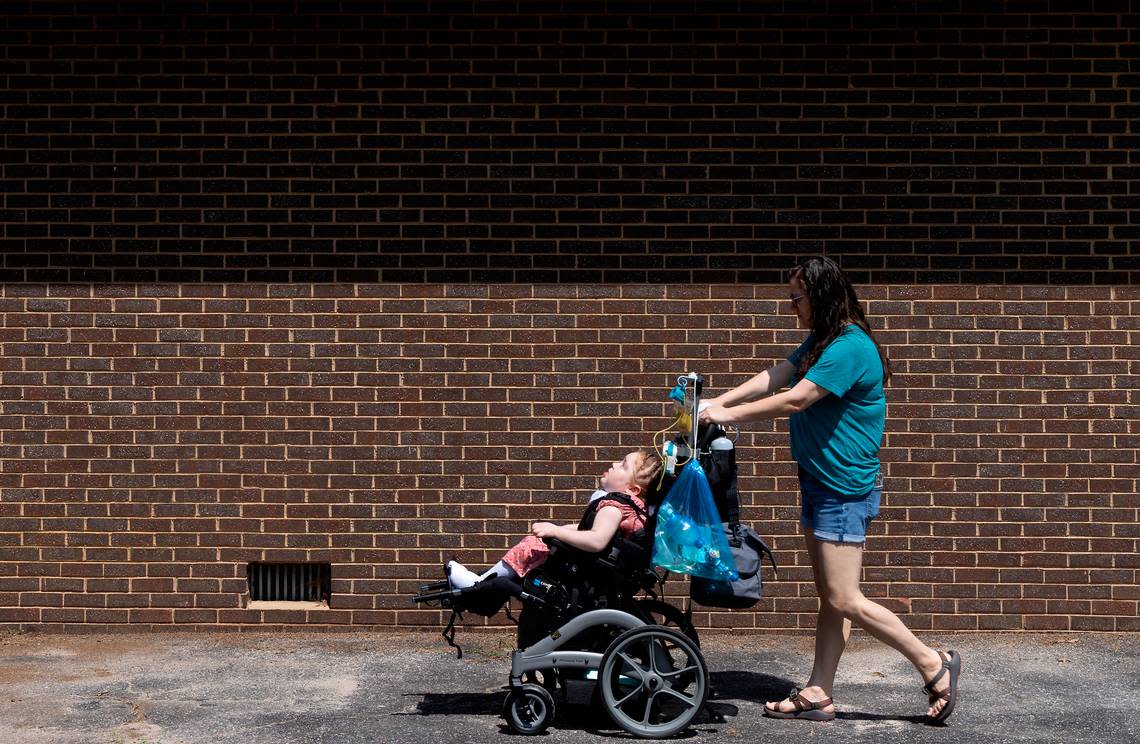Zero debt, 2% down: How NC couple bought first home using fractional ownership
For almost four years, Jennifer and Evan Emerson struggled to find a home suitable enough for their special-needs family in North Raleigh.
Having two children with Leigh syndrome, a rare genetic neurometabolic disorder, they had a list of non-negotiables: single story, close to WakeMed Health, handicap accessible. Both children use ventilators and wheelchairs.
It also had to be under $500,000. No small task in the Triangle’s competitive real estate market.
Finally, last October, they found the home of their dreams: a 2,700-square-foot, mid-century modernist gem, built in 1967, with its original kitchen and wood cabinetry. It even came with a separate mother-in-law’s suite.
But just as they were about to sign the offer letter, Evan, 40, a data analyst, got laid off.
“Obviously, that threw a pretty big wrench in [things],” said Jennifer, 36, who is a full-time caregiver to their children: Evangeline, 8, and Malachi, 6. She earns no salary.

For first-time buyers, like the Emersons, originally from Idaho, it’s never been harder as inflation, rising mortgage rates and high home prices keep homeownership out of reach for many across the Triangle and nationally.
Across the U.S., the percentage of first-time homebuyers dropped to a record low, according to the National Association of Realtors (NAR), making up one in four buyers in 2022, down from one in three buyers the year prior.
Without her husband’s job, the family no longer qualified for a traditional mortgage. Still, they put in their offer. The sellers, who knew the family’s situation, accepted it “with financing contingent.”
Don’t qualify for a mortgage? ‘Fractional ownership’ is an option. What to know.
Rent-to-Own 2.0
Enter Ownify, a California-based fractional-ownership startup that recently launched in the Triangle, its only market to date, after landing $7 million in seed funding led by Lobby Capital.
Like Divvy Homes and Home Partners, it’s one of several alternative home-financing solutions to turn up in the area from Silicon Valley in recent years, promising to help families achieve the American dream, even if they don’t qualify for a mortgage. (Ownify’s co-founder, Ben Herold, was Divvy Homes’ chief operating officer before launching Ownify.)
But unlike “rent-to-own” models, where buyers rent the property until they’ve saved for a down payment, Ownify’s model offers fractional ownership, or shared equity. In this case, instead of taking on debt, buyers partner with an equity provider to buy the home with cash. They make a comparatively low down payment of 2% and, while living in it, they build equity with a fixed monthly payment over time — roughly 1.6%, or about 13 “bricks,” per year.
Effectively, Ownify customers, nicknamed “Ownis,” buy their home “brick by brick,” the company said in its release. After five years, they own about 10% of their home’s equity. At that point, they can opt to buy the remaining equity, at fair market value, “or cash out and walk away.” Investors, in turn, earn rental income during those early years and, ideally, a large portion of the home’s appreciation.
For the Emersons, who learned about the program through their real estate agent, “it just felt too good to be true,” they said. But after meeting with the startup’s founders, they decided it was their best option. Within weeks, they’d signed on, effectively becoming the startup’s first customer and test run.

With their down payment, they bought a 2% stake outright in the four-bedroom, three-bathroom house, priced at $466,000, close to Northeast Raleigh. In return, Ownify backed an all-cash offer. It also covered additional upfront costs, such as due diligence fees and earnest money.
“After some issues showed up on inspections, the company even negotiated a price drop of around $34,000,” Jennifer Emerson said. The company also spent $48,000 for renovations, updating both bathrooms, repairing the crawl space, adding new floors and paint throughout.
Within weeks, the Emersons closed on the deal. Apart from having some issues securing a home equity loan — “we had to finagle some stuff with credit cards” — they had the same closing date as originally planned and moved in this February. They now make a fixed monthly payment of $3,300 to Ownify – just $20 more, the couple estimates, than they would have paid with a mortgage. Evan has also found a contract job that he expects to turn permanent.
“Had we not worked with Ownify, we probably wouldn’t have been able to get the house,” Jennifer Emerson said. Now, they feel they’ve got their American dream. “Especially for my husband. He’s going out, mowing the lawn, fixing things. He’s taking pride in our house.”

‘A balance of trade offs’
So, what’s the catch?
“There really isn’t one,” Ownify’s founder and CEO, Frank Rohde, who lives in San Francisco, told The N&O in a video call. “It’s a balance of trade offs as anything in life is.”
For years, he’d worked building mortgage-pricing software for firms like FICO and Nomis Solutions. He, himself, had to borrow money from his parents for the down payment on his first condo in San Francisco 15 years ago, he recalled. Recognizing not everyone has such funding streams, he was determined to build a solution that closed the gap. He wanted to target people, like young families and college graduates, who otherwise had good salaries but couldn’t afford a down payment because of student debt or lack of personal savings.
“It’s designed as an ‘on-ramp’,” he said. “We get the customer into the house. At the end of five years, or potentially earlier, they can use their equity as a down payment for a mortgage.”
On the plus side: Buyers get to better compete in the market with all-cash offers. They also take on less risk. If the house depreciates in value, they’re only underwater for their portion, not the entire property. But if the pendulum swings the other way, “the same is true,” he said.
Still, it’s not really option for people with bad credit, he said. The company currently requires a credit score of 680 or higher. As for the potential risks for defaults, taking on customers who might not otherwise qualify for a traditional mortgage, he remained nonplussed.
“’With the underwriting we’ve done, we’re pretty certain that we’re not going to see defaults.”
‘Consider your options’
Cory Sherman, a broker with Homegrown Real Estate in Durham, said he isn’t surprised by new mortgage products popping up. As higher rates squeeze many would-be buyers across Wake County, people are weighing their options.
While he conceded products, like Ownify, could offer a better alternative to renting, he also urged caution: “The FAQs don’t elaborate on what the process would look like if someone was faced with a hardship and couldn’t afford their payments. Going into a possible recession, this would be a major concern for me.”
He also pointed to other financing programs. Among them: State Employees’ Credit Union or an USDA loan, which offers up to 100% financing. Others, like an FHA loan, allow eligible buyers to pay as little as 3.5% of the purchase price for a down payment.
In all these scenarios, the buyer owns the property outright. “Most likely,” he said,”there are better alternatives available.”
